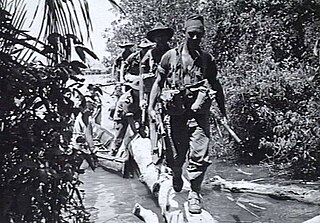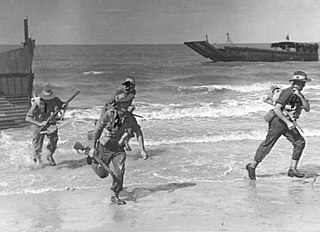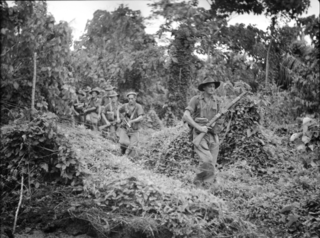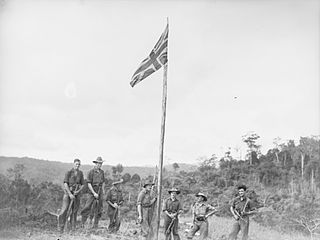
The 9th Division was a division of the Australian Army that served during World War II. It was the fourth division raised for the Second Australian Imperial Force. The distinctions of the division include it being:

The Borneo campaign or Second Battle of Borneo was the last major Allied campaign in the South West Pacific Area during World War II to liberate Japanese-held British Borneo and Dutch Borneo. Designated collectively as Operation Oboe, a series of amphibious assaults between 1 May and 21 July 1945 were conducted by the Australian I Corps, under Lieutenant-General Leslie Morshead, against Imperial Japanese forces who had been occupying the island since late 1941 – early 1942. The main Japanese formation on the island was the Thirty-Seventh Army under Lieutenant-General Masao Baba, while the naval garrison was commanded by Vice-Admiral Michiaki Kamada. The Australian ground forces were supported by US and other Allied air and naval forces, with the US providing the bulk of the shipping and logistic support necessary to conduct the operation. The campaign was initially planned to involve six stages, but eventually landings were undertaken at four locations: Tarakan, Labuan, North Borneo and Balikpapan. Guerrilla operations were also carried out by Dayak tribesmen and small numbers of Allied personnel in the interior of the island. While major combat operations were concluded by mid-July, localised fighting continued throughout Borneo until the end of the war in August. Initially intended to secure vital airfields and port facilities to support future operations, preparatory bombardment resulted in heavy damage to the island's infrastructure, including its oil production facilities. As a result, the strategic benefits the Allies gained from the campaign were negligible.

The Battle of Balikpapan was the concluding stage of Operation Oboe, the campaign to liberate Japanese-held British and Dutch Borneo. The landings took place on 1 July 1945. The Australian 7th Division, composed of the 18th, 21st and 25th Infantry Brigades, with a small number of Netherlands East Indies KNIL troops, made an amphibious landing, codenamed Operation Oboe Two, a few miles north of Balikpapan. The Allied invasion fleet consisted of around 100 ships. The landing had been preceded by heavy bombing and shelling by Australian and US air and naval forces. The Allied force totalled 33,000 personnel and was commanded by Major General Edward Milford, while the Japanese force, commanded by Rear Admiral Michiaki Kamada, numbered between 8,400 and 10,000, of which between 3,100 and 3,900 were combatants. After the initial landing, the Allies secured the town and its port, and then advanced along the coast and into the hinterland, capturing the two Japanese airfields. Major combat operations concluded around 21 July, but were followed by mopping-up operations, which lasted until the end of the war in mid-August. Australian troops remained in the area until early 1946.

The Battle of North Borneo took place during the Second World War between Allied and Japanese forces. Part of the wider Borneo campaign of the Pacific War, it was fought between 10 June and 15 August 1945 in North Borneo. The battle involved a series of amphibious landings by Australian forces on various points on the mainland around Brunei Bay and upon islands situated around the bay. Japanese opposition to the landings was sporadic initially, although as the campaign progressed a number of considerable clashes occurred and both sides suffered significant casualties, although major combat was largely restricted to Labuan and around Beaufort. On the mainland, while Allied conventional operations focused largely on the coastal areas around Brunei Bay, guerrilla forces consisting of Dayak tribesmen and small numbers of Allied personnel from the Services Reconnaissance Department fought an unconventional campaign in the interior. The Allies were successful in seizing control of the region. Nevertheless, many of the strategic gains that possession of North Borneo provided were ultimately negated by the sudden conclusion of the war in August 1945.

The Huon Peninsula campaign was a series of battles fought in north-eastern Papua New Guinea in 1943–1944 during the Second World War. The campaign formed the initial part of an offensive that the Allies launched in the Pacific in late 1943 and resulted in the Japanese being pushed north from Lae to Sio on the northern coast of New Guinea over the course of a four-month period. For the Australians, a significant advantage was gained through the technological edge that Allied industry had achieved over the Japanese by this phase of the war, while the Japanese were hampered by a lack of supplies and reinforcements due to Allied interdiction efforts at sea and in the air.

The Battle of Labuan was an engagement fought between Allied and Imperial Japanese forces on the island of Labuan off Borneo during June 1945. It formed part of the Australian invasion of North Borneo, and was initiated by the Allied forces as part of a plan to capture the Brunei Bay area and develop it into a base to support future offensives.

The 2/11th Commando Squadron was a commando unit raised by the Australian Army for service in World War II. Raised in 1944, the unit saw action late in the war against the Japanese during the Borneo campaign in 1945. As a part of this campaign the squadron undertook landings on Labuan Island and at Brunei Bay. Following the end of the war, the squadron returned to Australia and was disbanded in early 1946.

The 24th Brigade was a brigade-sized infantry unit of the Australian Army. Formed on 1 July 1940 as part of the Second Australian Imperial Force, the unit was raised for service during World War II. Originally formed as part of the 8th Australian Division the brigade was subsequently transferred to the newly created 9th Australian Division in December. The brigade served during the Western Desert Campaign, forming part of the Allied garrison during the Siege of Tobruk. Later, the brigade was withdrawn to Syria for occupation duties, but then later took part in the First and Second Battles of El Alamein. In early 1943, the brigade was returned to Australia to fight against the Japanese in the Pacific. In 1943–1944, the brigade fought in New Guinea, taking part in the landing at Lae and the Huon Peninsula campaign. Its final campaign came late in the war, when it took part in the Labuan landings and the Battle of North Borneo in mid-1945. After the war, the brigade was disbanded in early 1946.

The Battle of Wide Bay–Open Bay was a battle during the New Britain campaign of the Second World War. Following the arrival of the Australians on New Britain in late 1944, replacing the US garrison on the island, they began a limited offensive against the Japanese forces on the island. Pushing east from the positions previously captured by the US troops earlier in the year, after landing at Jacquinot Bay on the southern coast in November, the Australians began advancing across the island towards the Gazelle Peninsula, where they sought to isolate the numerically superior Japanese garrison. This advance was effected along two axes: Cape Hoskins to Open Bay on the northern coast, and Jacquinot Bay to Wide Bay on the southern. Once the Australians had secured a line across the island between Wide Bay and Open Bay in March and April 1945, the fighting on New Britain died down as the Australians sought to contain the larger Japanese garrison while limiting their own casualties. This situation lasted until the end of the war in August 1945.

The 2/43rd Battalion was an infantry battalion of the Australian Army. Raised in July 1940 in South Australia as part of the 24th Brigade, the battalion was initially part of the 8th Division, until the 24th Brigade was re-allocated to the 9th Division in late 1940. It was with this formation that the 2/43rd saw service in the Middle East in 1941–1942, taking part in the fighting at Tobruk and in the First and Second Battles of El Alamein. It also undertook garrison duties in Syria, before returning to Australia early in 1943 to fight against the Japanese in the Pacific.

The 2/2nd Machine Gun Battalion was an infantry support unit of the all-volunteer Second Australian Imperial Force that was raised for service overseas during the Second World War. Formed in mid-1940 in Sydney, from personnel drawn from the states of Queensland and New South Wales, the battalion was allocated to the Australian 9th Division. After completing training in Australia, the battalion operated in the Middle East between early 1941 and early 1943, seeing action against German and Italian forces at the First and Second Battles of El Alamein, and undertaking garrison duties in Syria as part of the Allied garrison that was established there after the Syria–Lebanon campaign.

The Battle of Finschhafen was part of the Huon Peninsula campaign in New Guinea during World War II and was fought between Australian and Japanese forces. The fighting took place between 22 September and 24 October 1943 following the landing at Scarlet Beach, which was followed by a two-pronged advance on Finschhafen as the Australian 20th Infantry Brigade advanced on the town from the north, while the 22nd Infantry Battalion drove from the south, having advanced from the landing beaches east of Lae. After the capture of Finschhafen, the Japanese forces in the area withdrew towards Sattelberg where they sought to hold the Australians before launching a counteroffensive, which subsequently threatened the landing beach. This attack was repelled by Australian and American forces, with heavy casualties being inflicted on the Japanese. In the aftermath, the Australians went on the offensive, capturing Sattelberg, and then advancing towards the Wareo plateau.

The Battle of Wareo was fought by Australian and Japanese forces in New Guinea during the Huon Peninsula campaign of World War II in the later part of 1943. Coming after the capture of Sattelberg by the Allies, the battle took place amidst the Australian advance north towards Sio. The Australians committed elements from four infantry brigades from the Australian 9th Division with supporting elements including artillery, engineers and tank support, while the Japanese force consisted primarily of two depleted infantry regiments from the 20th Division, with limited artillery support.

The 2/28th Battalion was an infantry battalion of the Australian Army, which served during the Second World War. Formed in mid-1940 from Western Australian volunteers, the battalion served in North Africa in 1941–42 as part of the 24th Brigade, which was assigned to the 9th Division. The battalion's first major engagement came during the Siege of Tobruk, where the battalion carried out defensive duties as part of the garrison for over six months before being withdrawn by sea. After undertaking occupation duties in Syria and Lebanon, the 2/28th took part in the First Battle of El Alamein in mid-1942 during which it was heavily depleted, and had to be rebuilt prior to its commitment to the Second Battle of El Alamein later in the year. In early 1943, the battalion returned to Australia and later took part in campaigns against the Japanese in New Guinea in 1943–44, where it was committed to capturing Lae, and then clearing the Huon Peninsula, and then retaking Borneo in 1945. After the war, the battalion was disbanded in early 1946.

The 2/24th Battalion was an infantry battalion of the Australian Army, which served during World War II. A unit of the all-volunteer Second Australian Imperial Force, it was formed in July 1940 from primarily Victorian volunteers and was known as "Wangaratta's Own" because of the time the battalion spent in the town during its formative period prior to deployment overseas. It served in North Africa in 1941–1942 as part of the 26th Brigade, which was assigned to the 7th Division, before being reassigned to the 9th Division. In early 1943, the battalion returned to Australia and later took part in campaigns against the Japanese in New Guinea in 1943–1944 and Borneo in 1945, before being disbanded in 1946. The 2/24th suffered the highest number of battle casualties of any 2nd AIF infantry battalion.

The 2/32nd Battalion was an infantry battalion of the Australian Army, which served during the Second World War. Formed in June 1940 from surplus Australian troops who had been sent to the United Kingdom shortly after the Fall of France, the battalion was originally designated the "71st Battalion", before being redesignated. After completing training in the United Kingdom, the 2/32nd served in North Africa in 1941–1942 as part of the 25th Brigade, which was assigned to the 9th Division, before being assigned to the 24th Brigade. In early 1943, the battalion returned to Australia and later took part in campaigns against the Japanese in New Guinea in 1943–1944 around Lae and on the Huon Peninsula, and in Borneo, landing on Labuan in mid-1945, before being disbanded in 1946.

Before the outbreak of World War II in the Pacific, the island of Borneo was divided into five territories. Four of the territories were in the north and under British control – Sarawak, Brunei, Labuan, an island, and British North Borneo; while the remainder, and bulk, of the island, was under the jurisdiction of the Dutch East Indies.
The 56th Independent Mixed Brigade was an Imperial Japanese Army unit of World War II. It was raised in June 1944 to reinforce the defences of Japanese-occupied Borneo, and was initially stationed in the north-east of the island. In early 1945 most of the brigade's units were ordered to move to the Brunei Bay area of west Borneo, with the brigade's personnel subsequently making a difficult march across the centre of the island.

The Battle of Madang, fought between early February and late April 1944, was the break-out and pursuit phase of the Markham and Ramu Valley – Finisterre Range and Huon Peninsula campaigns, which were part of the wider New Guinea campaign of World War II. After overcoming the Japanese defences around Shaggy Ridge, the Australian forces descended the steep slopes of the Finisterre Range and pursued the withdrawing Japanese towards Bogadjim and then Madang on the north coast of New Guinea. There they linked up with US and Australian forces that had advanced along the coast from the Huon Peninsula, while the remnants of three Japanese divisions withdrew towards Wewak, where further fighting would take place throughout late 1944 and into 1945.
The 25th Independent Mixed Regiment was a regiment of the Imperial Japanese Army (IJA) active during World War II. It was raised in July 1944, and deployed to Borneo in September that year. Elements of the regiment briefly saw combat against the United States Army on islands near Tawi-Tawi Island and against Australian forces during the Battle of North Borneo.



















